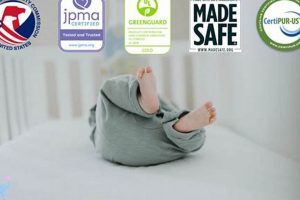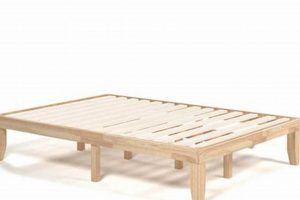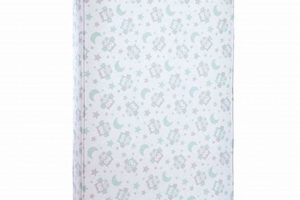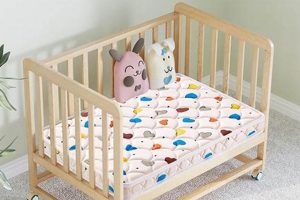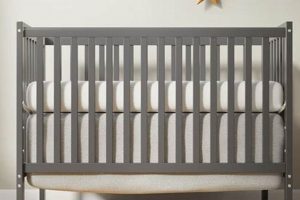A sleeping surface designed for smaller cribs manufactured by Babyletto, intended for infants, this product offers a compact alternative to standard-sized crib mattresses. Its dimensions are tailored to fit within the confines of a mini crib frame, providing a safe and comfortable sleep environment for newborns and young babies during their initial months.
Selecting the appropriate bedding is paramount for infant safety and well-being. Smaller mattresses address space limitations in nurseries or homes, allowing parents to provide a dedicated sleep space without the footprint of a full-sized crib. Historically, compact sleeping solutions have been employed in settings where space is at a premium, and this product reflects a modern adaptation of that need, combined with contemporary safety standards.
The subsequent discussion will examine various attributes and considerations relevant to selecting a mattress for a smaller crib, including construction materials, safety certifications, and factors influencing overall suitability for infant sleep.
Guidance on Choosing a Mattress for Babyletto Mini Cribs
The selection of a proper sleeping surface is crucial for infant well-being. These tips aim to inform the decision-making process when choosing an appropriate mattress for Babyletto mini cribs.
Tip 1: Verify Dimensional Compatibility. Confirm the mattress dimensions precisely match the interior measurements of the Babyletto mini crib. Gaps between the mattress edge and the crib frame pose a safety hazard.
Tip 2: Prioritize Firmness. A firm sleep surface is recommended for infants. The mattress should resist compression to prevent suffocation risks. Evaluate firmness by applying pressure to the mattress surface; minimal indentation is desirable.
Tip 3: Scrutinize Material Composition. Examine the materials used in the mattress construction. Opt for non-toxic, hypoallergenic materials that are free from harmful chemicals, such as phthalates and lead. Certifications like GREENGUARD Gold indicate lower chemical emissions.
Tip 4: Assess Cover Material. The mattress cover should be durable, waterproof, and easily cleanable. A wipeable surface helps maintain hygiene and prevents moisture absorption, which can promote bacterial growth.
Tip 5: Investigate Certifications. Look for certifications from reputable organizations that verify the mattress meets safety standards. Examples include JPMA certification, which signifies compliance with established safety regulations.
Tip 6: Consider Airflow and Breathability. A mattress with enhanced airflow can help regulate the infant’s body temperature and reduce the risk of overheating. Some mattresses feature breathable covers or core structures.
Tip 7: Check for Durability. The mattress should withstand regular use and cleaning without losing its shape or firmness. A durable mattress provides long-term value and ensures consistent support.
Proper mattress selection offers benefits including enhanced infant safety, improved sleep quality, and reduced exposure to potentially harmful substances. Adhering to these guidelines contributes to a healthier and more secure sleep environment.
The subsequent section will explore the long-term maintenance and care required to ensure the continued safety and effectiveness of the Babyletto mini crib mattress.
1. Dimensions
The dimensions of a mattress designed for Babyletto mini cribs are a critical specification directly influencing infant safety and the overall functionality of the crib. The cause-and-effect relationship is straightforward: incorrect dimensions create gaps between the mattress edge and the crib frame, posing a potential entrapment hazard for the infant. Accurate dimensions are, therefore, not merely a desirable feature but an essential component of a safe sleeping environment. For instance, a mattress that is even slightly undersized (e.g., less than 2 inches from the sides) can allow an infant to become wedged, leading to suffocation.
A specific example illustrating the practical significance is the adherence to industry standards like those set by the Juvenile Products Manufacturers Association (JPMA), which incorporates dimensional requirements. These standards dictate acceptable tolerances to minimize risk. Furthermore, practical application involves precise measurement of the interior of the Babyletto mini crib to ensure that the selected mattress aligns with these established safety parameters. The manufacturing of these products mandates consistent adherence to stated dimensional specifications, verified through quality control processes.
In summary, dimensional precision is paramount for mini crib mattresses. The challenge lies in ensuring both accurate manufacturing and informed consumer selection. Understanding the critical link between mattress dimensions and infant safety allows caregivers to make informed decisions, mitigating potential risks and establishing a secure sleep environment. This detail connects directly to the broader theme of product safety standards and responsible parenting.
2. Firmness
Firmness represents a critical safety parameter in the selection of a mattress for Babyletto mini cribs. Its importance stems from the direct correlation between mattress firmness and the risk of Sudden Infant Death Syndrome (SIDS) and suffocation. A sleep surface that is too soft increases the potential for an infant’s face to sink into the material, obstructing airways and compromising respiration.
- Role in Reducing Suffocation Risk
A firm mattress minimizes the likelihood of indentation when an infant is placed on it, regardless of sleeping position. A firm surface resists compression, maintaining a consistent plane that reduces the risk of the infant’s nose and mouth being obstructed. This is particularly relevant for infants who may roll onto their stomachs during sleep.
- Impact on Skeletal Development
While primarily a safety feature, appropriate firmness also contributes to proper skeletal development. A stable, firm surface provides consistent support for the infant’s spine during sleep. This is particularly relevant in the early months when the infant’s musculoskeletal system is rapidly developing.
- Standardization and Testing Protocols
Mattress firmness is subject to standardized testing protocols designed to ensure that products meet minimum safety requirements. These protocols involve measuring the degree of indentation under specified weights. Products failing to meet these requirements pose an unacceptable risk to infant safety. Certifications from organizations such as JPMA often indicate adherence to these standards.
- Differentiating Between Foam Types
The firmness of a mattress core is determined by the type and density of the foam used in its construction. High-density foam provides greater resistance to compression than lower-density alternatives. Parents should understand the relationship between foam density and firmness when evaluating a mattress for a Babyletto mini crib. Marketing claims regarding “orthopedic support” should be critically evaluated against objective firmness data.
The link between firmness and safety necessitates careful consideration during the mattress selection process. A surface deemed too soft presents an unacceptable risk, regardless of other purported benefits. Parents must prioritize firmness to ensure that the chosen mattress promotes a safe sleep environment, mitigating the risk of suffocation and supporting proper skeletal development. These facets highlights that while comfort is important, it should never come at the expense of infant safety, particularly as it relates to the surface of the sleep apparatus.
3. Materials
The composition of a mattress designed for Babyletto mini cribs is paramount, directly influencing infant safety, health, and overall product longevity. The materials employed determine the mattress’s potential toxicity, flammability, breathability, and durability. Therefore, material selection represents a critical factor in the manufacturing and purchasing decisions associated with such mattresses. For example, mattresses utilizing polyurethane foam, unless treated, pose a potential fire hazard. As a consequence, manufacturers often incorporate chemical flame retardants, some of which have raised health concerns due to potential endocrine disruption or carcinogenic properties.
A practical application of material understanding involves evaluating certifications such as GREENGUARD Gold, which indicates that a mattress has been tested for chemical emissions and meets stringent standards for volatile organic compounds (VOCs). Similarly, the presence of organic cotton or wool in the mattress cover can minimize exposure to synthetic pesticides and chemicals. For instance, some manufacturers utilize a wool barrier as a natural flame retardant, thereby avoiding the need for potentially harmful chemical treatments. The type of waterproofing used in the mattress cover is another vital consideration. Polyvinyl chloride (PVC) should be avoided due to phthalate content, while alternatives like polyethylene offer a safer and more environmentally sound option.
In summary, the choice of materials significantly impacts the safety profile and environmental footprint of a Babyletto mini crib mattress. The challenge lies in balancing safety requirements, such as flammability standards, with the desire to minimize exposure to potentially harmful chemicals. Informed consumer decisions, based on a thorough understanding of mattress materials and certifications, are essential for creating a healthier sleep environment for infants, further contributing to their well-being and safety, which forms the broader context of responsible product design and consumer education.
4. Safety Standards
The manufacture and sale of Babyletto mini crib mattresses are directly governed by stringent safety standards aimed at minimizing risks to infant health and well-being. These standards, established by regulatory bodies and industry organizations, dictate specific requirements related to mattress flammability, chemical emissions, structural integrity, and overall design. Non-compliance with these standards can lead to product recalls, legal liabilities, and, most importantly, potential harm to infants. For example, regulations such as the Consumer Product Safety Improvement Act (CPSIA) mandate limits on lead content and phthalates in children’s products, including crib mattresses. The practical effect is that manufacturers must rigorously test their products to demonstrate adherence to these chemical safety requirements.
Adherence to safety standards is not merely a legal obligation but a fundamental aspect of responsible product design. The standards function as a baseline for ensuring that Babyletto mini crib mattresses provide a safe sleep environment. For instance, flammability standards, such as 16 CFR Part 1633, require mattresses to resist ignition from common sources like cigarettes or open flames. To meet this requirement, manufacturers may use inherently flame-resistant materials or apply flame retardant treatments, subject to careful consideration of potential health impacts. Furthermore, structural standards address issues like mattress firmness, edge support, and overall stability to prevent suffocation hazards and ensure the mattress fits securely within the crib frame. Real-world examples of standard implementation include third-party testing and certification programs, such as those offered by the Juvenile Products Manufacturers Association (JPMA), which independently verify product compliance.
In summary, the rigorous application of safety standards is critical to the design, manufacture, and marketing of Babyletto mini crib mattresses. The inherent challenge lies in balancing safety requirements with material selection, cost considerations, and consumer preferences. A comprehensive understanding of applicable safety standards, combined with a commitment to responsible manufacturing practices, is essential for protecting infant health and maintaining consumer trust, ultimately tying into the broader context of product safety and consumer protection advocacy.
5. Cleanability
Maintaining a hygienic sleep environment is paramount for infant health. In the context of the Babyletto mini crib mattress, cleanability assumes particular importance due to the potential for frequent soiling and the unique vulnerabilities of newborns and infants to pathogens and allergens.
- Surface Material Impermeability
The mattress cover material is a primary determinant of cleanability. Impermeable surfaces, typically achieved through the use of a waterproof layer, prevent liquids from penetrating the mattress core, thereby inhibiting bacterial growth and the accumulation of allergens. For instance, a polyurethane laminate cover effectively repels fluids, facilitating easy wipe-down and disinfection. Conversely, absorbent materials, even if washable, can retain moisture and promote microbial proliferation.
- Ease of Disassembly and Cleaning of Components
Some Babyletto mini crib mattresses feature removable and washable covers, enhancing cleanability. The ability to detach the cover allows for thorough cleaning in a washing machine, removing embedded dirt, stains, and allergens. Non-removable covers necessitate spot cleaning, which may be less effective in eliminating deeply ingrained contaminants. A practical example is a zippered cover that can be easily removed for laundering following an incident of soiling.
- Resistance to Staining and Odor Retention
Certain mattress materials exhibit greater resistance to staining and odor retention than others. For example, fabrics treated with stain-resistant coatings minimize the absorption of spills and prevent discoloration. Antimicrobial treatments can further inhibit bacterial growth and the associated development of unpleasant odors. A real-world scenario involves comparing two mattresses subjected to identical soiling incidents; the mattress with stain-resistant and antimicrobial properties will likely exhibit superior long-term cleanliness.
- Compatibility with Cleaning Agents
The compatibility of the mattress cover with common cleaning agents is a significant consideration. Harsh chemicals can degrade certain materials, compromising their integrity and potentially releasing harmful substances. Manufacturers typically provide recommendations for appropriate cleaning agents and methods to ensure effective sanitation without damaging the mattress. For instance, using a mild, non-toxic disinfectant spray is often preferable to harsh bleach-based cleaners.
The interplay of these factors determines the overall cleanability of a Babyletto mini crib mattress. Prioritizing mattresses with impermeable surfaces, removable covers, stain and odor resistance, and compatibility with gentle cleaning agents ensures a more hygienic and safer sleep environment for infants. These details emphasize that cleanability must be viewed as a key selection criterion, complementing other factors such as firmness and material safety.
6. Support
The concept of support, when applied to a mattress designed for Babyletto mini cribs, extends beyond mere physical firmness. It encompasses the mattress’s ability to properly align the infant’s developing spine, distribute weight evenly, and maintain its structural integrity over time. Adequate support is critical for promoting healthy musculoskeletal development and ensuring a safe and comfortable sleep environment.
- Spinal Alignment
A mattress that provides appropriate support helps maintain the natural curvature of the infant’s spine, preventing undue stress or strain on developing muscles and ligaments. A lack of adequate support can lead to postural problems or discomfort, potentially affecting sleep quality. For example, a mattress that sags excessively may cause the infant’s spine to curve unnaturally, leading to musculoskeletal imbalances. A mattress with adequate support ensures the spine is properly aligned, promoting healthy development. This aspect is particularly critical for infants, whose skeletal systems are still highly malleable.
- Weight Distribution
Uniform weight distribution is essential for preventing pressure points and promoting restful sleep. A mattress that effectively distributes weight minimizes the risk of localized pressure on specific areas of the infant’s body, such as the head or hips. Uneven weight distribution can lead to discomfort and restlessness, disrupting sleep patterns. Real-world examples include mattresses with zoned support systems, which provide targeted support to different areas of the body, ensuring even weight distribution and minimizing pressure points. Consistent support throughout the mattress surface is crucial for preventing localized pressure and promoting restful sleep.
- Edge Support and Stability
Adequate edge support is crucial for preventing roll-off and maximizing the usable surface area of the mattress. A mattress with firm edges provides a stable perimeter, reducing the risk of the infant rolling off the mattress, particularly as they become more mobile. Poor edge support can also compromise the structural integrity of the mattress, leading to sagging and uneven support. This is particularly relevant for mini crib mattresses, which have a smaller surface area; robust edge support helps maximize the usable space and prevent accidents.
The facets of spinal alignment, weight distribution, and edge support collectively define the overall support characteristics of a Babyletto mini crib mattress. Prioritizing these aspects ensures that the selected mattress provides a safe and comfortable sleep environment that promotes healthy musculoskeletal development and minimizes the risk of accidents. Evaluating these details provides for the long-term effectiveness of a mattress and ensuring a sound and secure sleep.
Frequently Asked Questions about Babyletto Mini Crib Mattresses
The following addresses common inquiries and concerns regarding Babyletto mini crib mattresses. It aims to provide clear and factual information to assist in making informed purchasing and usage decisions.
Question 1: What are the standard dimensions for a Babyletto mini crib mattress?
Standard dimensions for a Babyletto mini crib mattress typically measure approximately 24 inches wide by 38 inches long. Precise measurements may vary slightly by model. It is imperative to verify the interior dimensions of the specific Babyletto mini crib model before selecting a mattress to ensure a snug and safe fit.
Question 2: What level of firmness is recommended for a Babyletto mini crib mattress?
A firm mattress is recommended for infant safety. Excessive softness can pose a suffocation hazard. The surface should resist indentation when pressure is applied. Third-party certifications may indicate compliance with established firmness standards.
Question 3: What materials should be avoided in a Babyletto mini crib mattress?
Materials known to off-gas harmful chemicals or containing potentially toxic substances should be avoided. Polyvinyl chloride (PVC), phthalates, and chemical flame retardants are examples of materials that warrant careful consideration and potential avoidance.
Question 4: How frequently should a Babyletto mini crib mattress be cleaned?
The mattress should be cleaned immediately following any soiling incident. Regular spot cleaning is advisable to maintain hygiene. If the mattress cover is removable and machine-washable, it should be laundered periodically according to the manufacturer’s instructions.
Question 5: What safety certifications should one look for when purchasing a Babyletto mini crib mattress?
Certifications from reputable organizations, such as GREENGUARD Gold and JPMA, indicate that the mattress has been tested and meets specific safety standards. These certifications verify compliance with regulations regarding chemical emissions, flammability, and structural integrity.
Question 6: How does a smaller mattress for babies affect the comfort or quality sleep?
Babyletto mattresses for babies are made for small spaces, but they do not affect the sleep quality for babies, as it provides comfort too. However, if the mattress for babies is too small for the baby, then there is a chance that it affects the comfort or quality of sleep because they will be unrest.
In summary, the selection and maintenance of a Babyletto mini crib mattress necessitate careful attention to dimensions, firmness, material composition, cleanability, and safety certifications. Adherence to established guidelines promotes a safe and hygienic sleep environment for infants.
The following section will provide a concluding summary of key points and recommendations regarding Babyletto mini crib mattresses.
Conclusion
The preceding analysis has explored diverse aspects of the “babyletto mini crib mattress,” ranging from dimensional specifications and material composition to safety standards and maintenance protocols. Key findings underscore the paramount importance of firmness, non-toxic materials, dimensional accuracy, and verifiable safety certifications. These elements collectively contribute to creating a secure and hygienic sleep environment for infants.
The selection of a sleeping surface for infants demands meticulous attention to detail and a thorough understanding of established safety guidelines. Continued adherence to these principles, coupled with ongoing research and innovation in product design, is essential for safeguarding infant health and promoting optimal developmental outcomes. Prioritizing safety and informed decision-making remains the cornerstone of responsible care.



